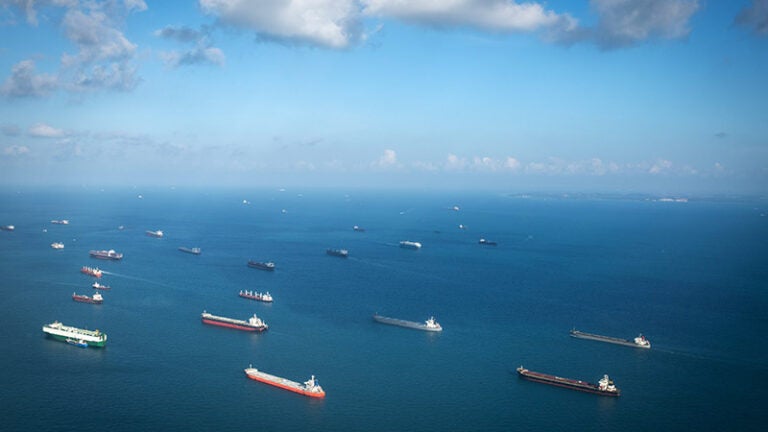
What is the L.A. port’s shipping backlog doing to Southern California’s environment?
James Fawcett knows shipping.
His decades-long career includes service in the U.S. Navy as a ship pilot and communications officer, plus a decade as a port manager and chief of planning for Los Angeles County’s Department of Beaches and Harbors.
He has spent the last 25 years with USC Sea Grant, a part of the USC Wrigley Institute for Environmental Studies at the USC Dornsife College of Letters, Arts and Sciences, where he serves as the program’s extension lead and marine transportation and seaport specialist. In both roles, he serves as a link between campus researchers, the marine transportation industry, government and the public on seaport operations and management, movement of marine freight, and the environmental impacts of this industry on Southern California and the nation.
He is also adjunct professor of environmental studies at USC Dornsife and holds a joint appointment at the USC Sol Price School of Public Policy, teaching marine environmental policy and coastal management.
In light of the shipping topics reaching the news in recent months, including the stalled supply chain, overpopulated ports and record numbers of idling ships off Southern California’s coast, Fawcett answered questions about this current situation and how it may be impacting our local environment.
The Ports of Los Angeles and Long Beach have been in the press recently because of the backup in goods movement at the ports. What should the public know about the backup?
These two independent ports are the busiest container ports in the U.S. and are served by many shipping companies, most of them internationally owned. It is important to remember that the backup is a systemproblem that is most obvious at the ports but involves multiple contributing sub-systems: trucking, railroads and warehousing. Also, the backup is a problem not only in the U.S. but also overseas. In other words, our two ports aren’t necessarily the cause of the problem; the congestion is just more visible there. And, once the system gets out of whack as it has this past year, it takes time for it to recover back to normal across the world.
What’s the most prominent environmental impact of this congestion?
Maritime shipping is a highly regulated industry, with rules that govern acceptable fuels worldwide. These rules are even more stringent within 200 miles of the North American coast. Nevertheless, modern container ships are propelled by diesel engines, which burn petroleum-based fuel and emit hydrocarbons into the air. So, the most prominent environmental impact is a reduction in air quality. This is especially pronounced in Southern California because the prevailing wind on our coast is from the west, and air pollution becomes trapped in our air basin.
As a region, we have tackled this topic for more than 50 years in an effort to reduce the impacts of air pollutants from all manner of sources, from cars to industrial processes. As a result, our air is now cleaner, and government has become more focused on maritime-generated air pollution and its impact on the environment.
Can our ports do something about air pollution?
Yes, and in fact, they have.
In 2006, the two ports created the joint Clean Air Action Plan. It involves a number of features, such as requiring that all trucks serving the ports be either replaced with newer models or have their engines replaced with those that meet the EPA 2007 emission standards.
As another measure, both ports are electrifying their berths to enable ships to completely shut down their engines and use electricity generated by utility companies, which is much cleaner and more efficient than the ships’ own diesel powerplants.
In a third dimension, ships approaching the ports between the central California coast and the Mexican border are tracked by the Vessel Traffic Service of the Marine Exchange of Southern California. Incentive programs are in place to help reduce emissions. For instance, ships that reduce their speed within 40 nautical miles from the port entrances can receive discounts from the ports on their port docking charges. Even those slowing down within 20 nautical miles of the entrances can receive a more limited discount.
How are other environmental impacts of shipping managed?
In 1973 and again in 1978, the International Maritime Organization began implementing the terms of the International Convention for the Prevention of Pollution at Sea, referred to as MARPOL 73/78, to minimize pollution of our oceans. It regulates six issues, or “Annexes”: 1) pollution from oil; 2) pollution from poisonous liquid substances in bulk; 3) pollution from harmful substances carried at sea in packaged form; 4) pollution from ship-generated sewage; 5) garbage pollution generated by ships; and 6) air pollution generated by burning maritime fuels.
The U.S. has signed agreement to Annexes 1, 2, 3, 5 and 6. Ships entering any seaport of a nation that is a signatory to MARPOL, which covers about 150 nations, must be able to demonstrate compliance with the terms of the convention. For example, with respect to Annex 5, garbage must be kept onboard until it reaches port and then discharged at an appropriate receiving station.
What can the public do to help reduce pollution related to marine traffic?
First, don’t throw garbage overboard when sailing for pleasure. More importantly, remember that in our oceanside location (which is the entire Los Angeles metro area), everything disposed of in the street will find its way to a storm drain that ultimately empties into the ocean. This is especially important to remember with anything made of plastic because the lifespan of plastic debris can be decades long, if not longer.
Another way the public can get involved is by reading USC Sea Grant’s Ship’s Log online series to stay educated and up to date about shipping topics that are relevant along our coast.
The positive impact of millions of small-scale efforts can have a huge impact on the health of our coastal waters.